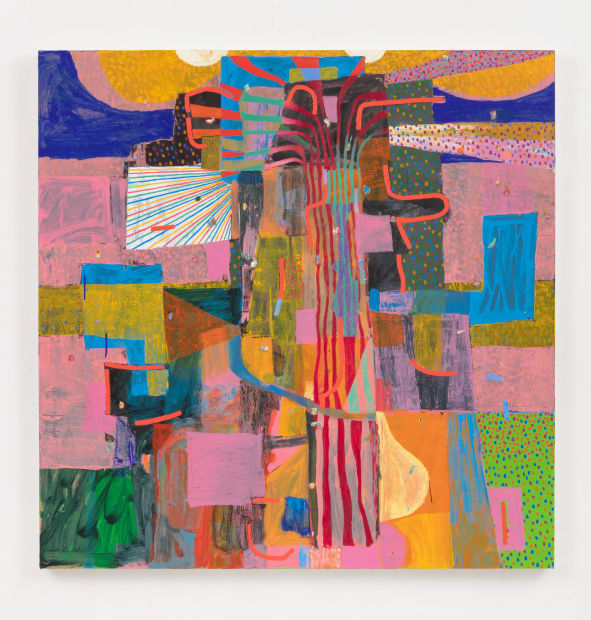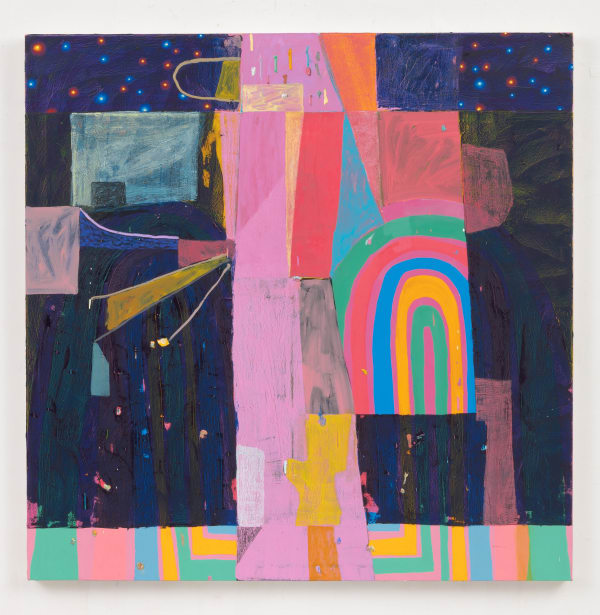-
“I have often talked about paintings being inherently contradictory things. They are objects that are spaces, walls that are windows. They are the intersection of object and image. Painting maintains a physical anchor at a time when the image generally is becoming more and more ethereal—everywhere and nowhere at the same time.” –Tomory Dodge
-

-
In his newest body of work Dodge continues his investigation into the pictorial elements of form. Filled with patterned dots, scraped away paint and vivid lines, there is an expressive, psychedelic component that emerges from his work. Dodge’s paintings are born and reborn through additive paint application as well as subtractive techniques - a continuous process of painting and scraping.
-

-
For Dodge, any perceived endpoint is a pathway to a new beginning. Inscribed lines roll across the surface resulting in interrupting shapes and repeated patterns, which act as a kind of visually collaged screen that simultaneously defines and filters out an easily identifiable and recognizable form.
-

-
In a sense, Dodge’s paintings take the viewer back to 1912-14 Synthetic Cubism, and the work of artists like Picasso and Braque. Using collage as a means of expression, Synthetic Cubism breaks down the ideas of Analytic Cubism by flattening out a multiple viewpoint figure and reconfiguring it. Dodge’s visually referenced collage creates fields of color that are broken up by collaged geometric shapes. Schematic dots applied with a tipped brush push the feeling of these fields and shapes. The pictorial space once deconstructed is reassembled to form a new plane and dimensionality.
-

-
Dodge's use of color highlights dynamic interactions and relationships between hues and creates an alluring draw for the viewer. Heavily process-based, the end goal is not to nail down a specific color but to create relationships and conversations between each color itself. In Dodge's paintings, the feeling and emotion of color relationships become increasingly apparent and provide an expressionistic entry point.
-

-
Tomory Dodge’s dynamic paintings also explore representation and the mechanics of picture-making. He writes, “I have often talked about paintings being inherently contradictory things. They are objects that are spaces, walls that are windows. They are the intersection of object and image."
-

-
Works by Tomory Dodge
Click image to inquire -
Press Release
Philip Martin Gallery is proud to present an exhibition of new oil-on-canvas paintings by Tomory Dodge. Dodge’s work - known for its unique use of line, color, painted layers, and expressive textures - captures a sense of regeneration in idiosyncratic abstraction.
In his newest body of work Dodge continues his investigation into the pictorial elements of form. Filled with patterned dots, scraped away paint and vivid lines, there is an expressive, psychedelic component that emerges from his work. Dodge’s paintings are born and reborn through additive paint application as well as subtractive techniques - a continuous process of painting and scraping. For Dodge, any perceived endpoint is a pathway to a new beginning. Inscribed lines roll across the surface resulting in interrupting shapes and repeated patterns, which act as a kind of visually collaged screen that simultaneously defines and filters out an easily identifiable and recognizable form.
In a sense, Dodge’s paintings take the viewer back to 1912-14 Synthetic Cubism, and the work of artists like Picasso and Braque. Using collage as a means of expression, Synthetic Cubism breaks down the ideas of Analytic Cubism by flattening out a multiple viewpoint figure and reconfiguring it. Dodge’s visually referenced collage creates fields of color that are broken up by collaged geometric shapes. Schematic dots applied with a tipped brush push the feeling of these fields and shapes. The pictorial space once deconstructed is reassembled to form a new plane and dimensionality.
Dodge's use of color highlights dynamic interactions and relationships between hues and creates an alluring draw for the viewer. Heavily process-based, the end goal is not to nail down a specific color but to create relationships and conversations between each color itself. In Dodge's paintings, the feeling and emotion of color relationships become increasingly apparent and provide an expressionistic entry point.
Tomory Dodge’s dynamic paintings also explore representation and the mechanics of picture-making. He writes, “I have often talked about paintings being inherently contradictory things. They are objects that are spaces, walls that are windows. They are the intersection of object and image. Painting maintains a physical anchor at a time when the image generally is becoming more and more ethereal—everywhere and nowhere at the same time.” Painting’s power to represent images and events means that we often forget the fact that paintings themselves are a matrix of applied material signs. The vision of the painter and the subjects that they depict are figured through brushstroke, color, and texture. Dodge comments, “Paradoxically, similar to Analytic Cubism perhaps, the attempt to understand something in its totality often results in partially obscuring it.” Within Dodge’s oil-on-canvas paintings, many smaller “paintings” seem to jostle together, making room for themselves within the greater composition.
Tomory Dodge (b. 1974, Denver, CO) received his BFA from Rhode Island School of Design (Providence, RI) in 1998 and his MFA from California Institute of the Arts (Valencia, CA) in 2004. Tomory Dodge will have a solo exhibition at Philip Martin Gallery (Los Angeles, CA) February 19- March 22, 2022. Tomory Dodge’s work was recently featured on David Zwirner Gallery Platform; in spring 2021, a major painting by Tomory Dodge was acquired by the Los Angeles County Museum of Art (Los Angeles, CA). Recent solo exhibitions include Miles McEnery Gallery (New York, NY); LUX Art Institute (Encinitas, CA); “Stranger Than Paradise,” Rhode Island School of Design Museum (Providence, RI); “Grafforists,” Torrance Art Museum (Torrance, CA); “Nowism,” Pizzuti Collection (Columbus, OH); “An Appetite For Painting,” National Museum (Oslo, Norway); “Pouring It On,” Herter Art Gallery, University of Massachusetts (Amherst, MA); “Tomory Dodge and Denise Thomasos: Directions to a Dirty Place,” Southeastern Center for Contemporary Art (Winston-Salem, NC); “Future Tense: Reshaping the Landscape,” Neuberger Museum of Art (Purchase, NY); “American Soil,” Nerman Museum of Contemporary Art (Overland Park, KS); “Sheldon Survey,” Sheldon Memorial Gallery, University of Nebraska (Lincoln, NE). His work is in the collections of such museums as Los Angeles County Museum of Art (Los Angeles, CA); Orange County Museum of Art (Newport Beach, CA); San Francisco Museum of Modern Art, (San Francisco, CA); Berkeley Art Museum and Pacific Film Archive (Berkeley, CA); Henry Art Gallery (Seattle, WA); Dallas Museum of Art (Dallas, TX); Nerman Museum of Contemporary Art (Overland Park, KS); Weisman Art Museum (Minneapolis, MN); Minneapolis Institute of Art (Minneapolis, MN); Orlando Museum of Art (Orlando, FL); Knoxville Museum of Art (Knoxville, TN); Weatherspoon Art Museum (Greensboro, NC); Smithsonian American Art Museum (Washington, DC); RISD Museum, Rhode Island School of Design (Providence, RI); Yale University Art Gallery (New Haven, CT); and Whitney Museum of American Art (New York, NY). Dodge’s work is the subject of several monographic catalogs and has been discussed in such publications as Artforum, Flash Art, Modern Painters, Art Review, Los Angeles Times, and The New York Times. Dodge lives and works in Los Angeles, CA.
-
To inquire about works by Tomory Dodge, click here.
Tomory Dodge
Past viewing_room













